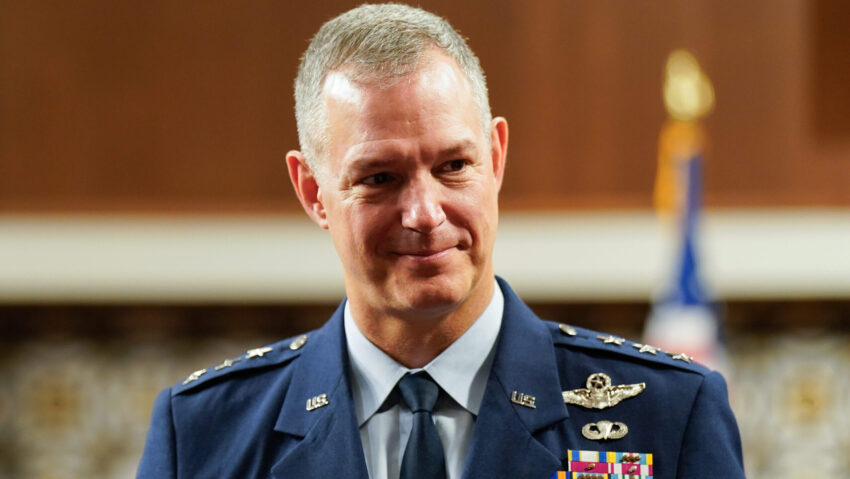Lt. Gen. Alexus Grynkewich, commander of the United States European Command and Supreme Allied Commander nominee for US President Donald Trump, arrives for a Senate Armed Services Committee confirmation hearing in Washington, DC, US, on Tuesday, June 24, 2025. (Al Drago/Bloomberg via Getty Images)
WASHINGTON — With most NATO members committed to spending 5 percent of their GDP within a decade, key US military leaders are preparing to help organize the flow of massive defense investments.
“If confirmed … one of my major responsibilities is to ensure that any increased spending was done in a way that benefited the Alliance and ensure the achievement of capability targets that the Alliance has agreed to,” US Air Force Lt. Gen. Alexus Grynkewich, the White House’s pick to be the next commander for US European Command and the Supreme Allied Commander of Europe, told lawmakers during his nomination hearing on Tuesday.
NATO members gathered in The Hague this week where the allies, where allies signed the 5 percent pledge. That agreement commits the signatories to spending 3.5 percent of their annual GDP on defense by 2035 with another 1.5 percent directed to protecting critical infrastructure, defending networks, ensuring civil preparedness and resilience, innovation, and bolstering the defense industrial base.
Just where those dollars will flow is not nailed down, but NATO has begun planning how to help direct that spending to include drawing up requirements and capabilities roadmaps.
“The details of our plans are of course classified but let me give you a few examples of what we will invest in,” NATO Secretary General Mark Rutte said during a pre-summit address.
“[There will be] a five-fold increase in air defense capabilities,” he added. “Because we see Russia’s deadly terror from the skies over Ukraine every day, and we must be able to defend ourselves from such attacks. Thousands more tanks and armored vehicles because even though warfare is changing fast, we still need to be able to protect our soldiers on the battlefield, and to maneuver. And millions of rounds of artillery ammunition, because it is by having these stockpiles that we can deter aggression from any threat.”
If Grynkewich is confirmed by the Senate, in his capacity as SACEUR he will play a pivotal role in overseeing this process and said he is eager to work with each country to play to their strengths.
“Some countries are very strong in the land domain, others have a stronger position in the maritime domain and within all of the domains, there’s, of course, a variety of capabilities,” Grynkewich told members of the Senate Armed Services Committee. “My goal would be to work very hard with our allies and partners in the region to bring all of that together in a coherent fashion, to increase the strength of the Alliance.”
When it comes to land-based investments, for example, the head of US Army Europe and Africa and the commander of NATO Allied Land Command Gen. Christopher Donahue is helping lead the charge.
Speaking at an Association of the US Army breakfast today, Donahue said there is an “incredible opportunity” for defense investment now, to include the US sector that funnels the majority of foreign military sales to NATO nations.
“Anytime anyone gets infused with a lot of money, what do they do? They invest in themselves, right? So, we have to make sure, from a coproduction perspective … [that] we’re getting with European industry very quickly.”
Part of that rush, he added, is to ensure interoperability between countries and their equipment.
“I’m very worried about interoperability. I’m very worried that people aren’t going to develop stuff that will work together, just because the pressure to do stuff is so fast, right, that we have to make sure that we’re doing at the right speed and pace, but we’re not driving into a box,” Donahue said.
As European nations prepare to pour billions of dollars into their defense budgets, it comes at a precarious time for the US with swirling questions about the Trump administration’s commitment to NATO, its force posture in Europe and role on the international stage.
While there have been reports that the US Army may shrink its European footprint, no decision has been formally unfurled and Donahue said he is not expecting a big shakeup.
“I don’t think that our force posture is going to change at all … and nobody has said anything to me about it,” he said
“I’ve met with all the senior leaders. So, what I tell all my NATO brethren is, in fact, the last time we had growth in Europe was actually the first Trump administration,” the four-star general added.
Michael Marrow contributed to this report from the Hague.
Click this link for the original source of this article.
Author: Ashley Roque
This content is courtesy of, and owned and copyrighted by, https://breakingdefense.com and its author. This content is made available by use of the public RSS feed offered by the host site and is used for educational purposes only. If you are the author or represent the host site and would like this content removed now and in the future, please contact USSANews.com using the email address in the Contact page found in the website menu.








